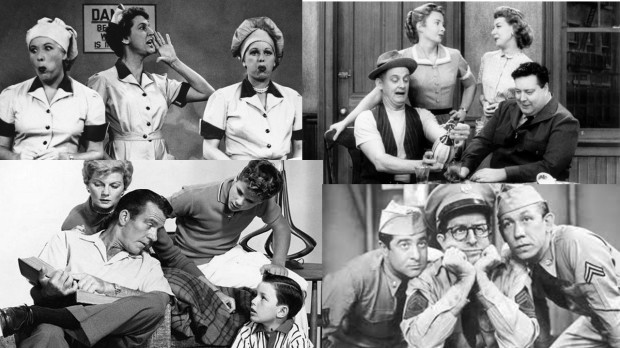THE REAL REASON THERE WAS A “GOLDEN AGE OF TELEVISION”
by James Perloff:
 One day in the 1970s, my sister and I, both twenty-somethings, were visiting my father’s house. We flicked on the TV. For some reason, the local station departed from its standard routine and played something we’d never seen before: one of the dramas uniquely featured in the 1950s. There were a few of these “anthology series”: Playhouse 90, Studio One, General Electric Theater, Robert Montgomery Presents, Philco Television Playhouse and several others. They featured individual dramas with a new cast each week; they were not the formulaic series that had become rigorously standard by the 1960s, with every show employing the same cast in new scripts. (I won’t embed it here, but for an example of what these dramas could be like, I’ll recommend Playhouse 90’s The Comedian from 1957 on YouTube.)
One day in the 1970s, my sister and I, both twenty-somethings, were visiting my father’s house. We flicked on the TV. For some reason, the local station departed from its standard routine and played something we’d never seen before: one of the dramas uniquely featured in the 1950s. There were a few of these “anthology series”: Playhouse 90, Studio One, General Electric Theater, Robert Montgomery Presents, Philco Television Playhouse and several others. They featured individual dramas with a new cast each week; they were not the formulaic series that had become rigorously standard by the 1960s, with every show employing the same cast in new scripts. (I won’t embed it here, but for an example of what these dramas could be like, I’ll recommend Playhouse 90’s The Comedian from 1957 on YouTube.)
I don’t recall which anthology series my sister and I encountered that day, or the name of the play. But I do know that for the next 60 minutes—or was it 90?—we sat spellbound, watching one of the best-written, best-acted dramas we’d ever seen. We were somewhat “literate” regarding drama, because my father was a salesman, and his company always gave him tickets to take customers to plays in Boston—which was Broadway’s “trial run” city for new shows. When Dad’s customers couldn’t make it, the family got to go, so we spent many a night viewing Broadway’s best at the Schubert, Wilbur, and Colonial theaters.
After the TV drama finished, my sister and I discussed it at length. Why was it, we asked, that television no longer featured high-quality entertainment like that? We didn’t quite realize it, but we had just stepped in and out of a personal Twilight Zone moment—a trip into the lost “Golden Age of Television.“
Of course, we had tasted the “Golden Age” in real time (my family succumbed to social pressures and bought its first television set in 1955 or 1956)—but my sister and I were then only ready mostly for the kiddie shows.
For decades, TV’s “Golden Age” was, and still is by many, remembered nostalgically. Though many of my younger readers won’t know them, some of the best-loved staples were I Love Lucy, The Honeymooners, and Leave It to Beaver. What made that era so memorable? Sure, it was new and innovative at the time, and shows were often live instead of prerecorded (adding an appeal of unpredictability). Initially, audience laughter was almost always genuine instead of “canned.” But I credit a more profound reason for the attraction.
About 10 years ago, I was looking over the 1959 TV lineup. There were only three networks back then, hence just three competing choices. Yet my eyes got a little misty as I realized that if I were transported to 1959, I’d be more conflicted trying to decide “which show to watch” than with the literally hundreds of choices cable TV was offering. (This has recently changed somewhat, due to the increasing arrival of networks like MeTV, which air vintage shows, helping ensure senior citizens stay just as distracted as the younger denizens of “the Matrix.”)
I believe what made that era’s shows so appealing was essentially their morality. 1950s television permitted no cursing or sex scenes; any violence wasn’t graphic. Furthermore, most shows’ plots ended with a positive moral lesson. Honesty, respect for others, “doing the right thing,” self-control, and other virtues were upheld. Superman began every episode reminding children that Superman fought for “truth, justice, and the American way.”
On 50s TV, crime couldn’t pay. (Alfred Hitchcock had a uniquely clever way of circumventing this rule on his show; the criminals would often “get away with it,” but in his epilogue, Hitch would dryly remark that they were later caught and paid their debt to society.)
Although Leave It to Beaver became, in recent years, a favorite target for ridicule by jaded comedians, when I attended elementary school my classmates avidly watched it. Almost every story presented a right-or-wrong choice for Beaver (and/or his brother Wally). Temptation usually came from Wally’s friend Eddie Haskell, and sound advice from the brothers’ father, Ward Cleaver. In retrospect, Eddie and Ward seemed to loosely symbolize the counsel of Lucifer and God. I find it interesting that, in real life, actor Ken Osmond (Eddie) went on to become a Los Angeles policeman, and actor Hugh Beaumont (Ward) held a Master’s Degree in Theology and was licensed to preach by the Methodist Church.1 The cast clearly included some righteous dudes.
So why did all this change? It certainly wasn’t because Americans demanded that cursing, sex and gore be added to their TV diet. As a journalist for three decades, and student of “the New World Order” for four, I’ve realized that 1950s television was a carefully set trap. To lure a mouse into the trap, you’ve got to insert some cheese.
In this case, the “cheese” was television’s façade as a positive tool that would teach your children integrity and uplifting life perspectives. And that’s just what it did (even though it occasionally pushed messages a bit to the left of America’s center). I believe the nostalgia Americans generally feel for the 1950s is based largely on the values society held, and that television was in fact reinforcing those values by presenting strong role models.
If you watch The Honeymooners, the show was hilarious, but Ralph would almost invariably learn a life lesson along the way, classically hugging his forgiving wife with the closing words, “Baby, you’re the greatest!”
Even with the conniving Sergeant Bilko (1955-59), the earlier episodes usually ended with a heartfelt message—such as Bilko expressing regrets at having cheated someone—whereas by the final season everything was strictly for laughs at the sergeant’s cunning and greed; the ratings dropped and the show was cancelled.
America society was prevailingly Christian then. To get television into those households required presenting it as a purveyor of Christian morals, however repugnant that may have been to studio heads’ true feelings.
The very first hit song ever introduced on TV was 1953’s “I Believe,”2 all about faith in God. I don’t think a video clip of the original telecast exists, but here’s the song, which reached #2 on the charts:
Wink Martindale’s cover of “The Deck of Cards” hit No. 7 on the 1959 Billboard charts:
Church, God, and positive portrayals of ministers were standard in the 1950s. When my wife asked what I wanted for a gift last Christmas, I suggested a DVD collection of 17 Studio One (1948-58) dramas, which included the first-ever filming of Orwell’s 1984. While I can’t say I found all the episodes commendable, the godly references in some struck me. In “The Strike,” an army major in the Korean War gets very theological with the chaplain after learning a patrol he’s sent out must be sacrificed in an inevitable air strike. In another, “The Death and Life of Larry Benson,” a family has joyfully learned that their son was not killed in Korea as first reported. But when they reach the train station, they discover their “son” is actually a mentally troubled GI, a battlefield friend who had taken on their son’s identity. After initial shock and rejection, they accept him into their family, and the father, who had previously given up on God, heads with the others to church as the bells ring.


